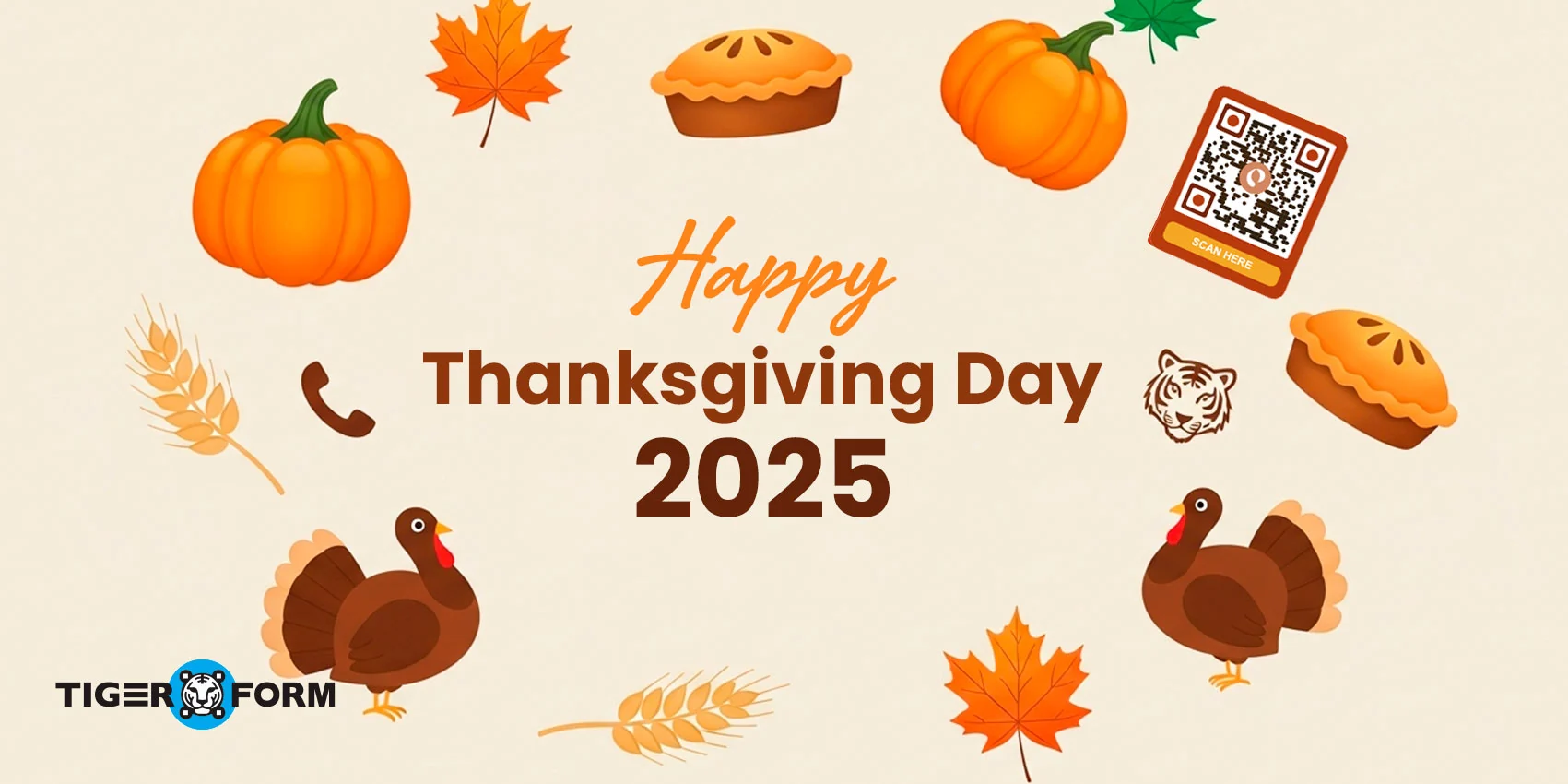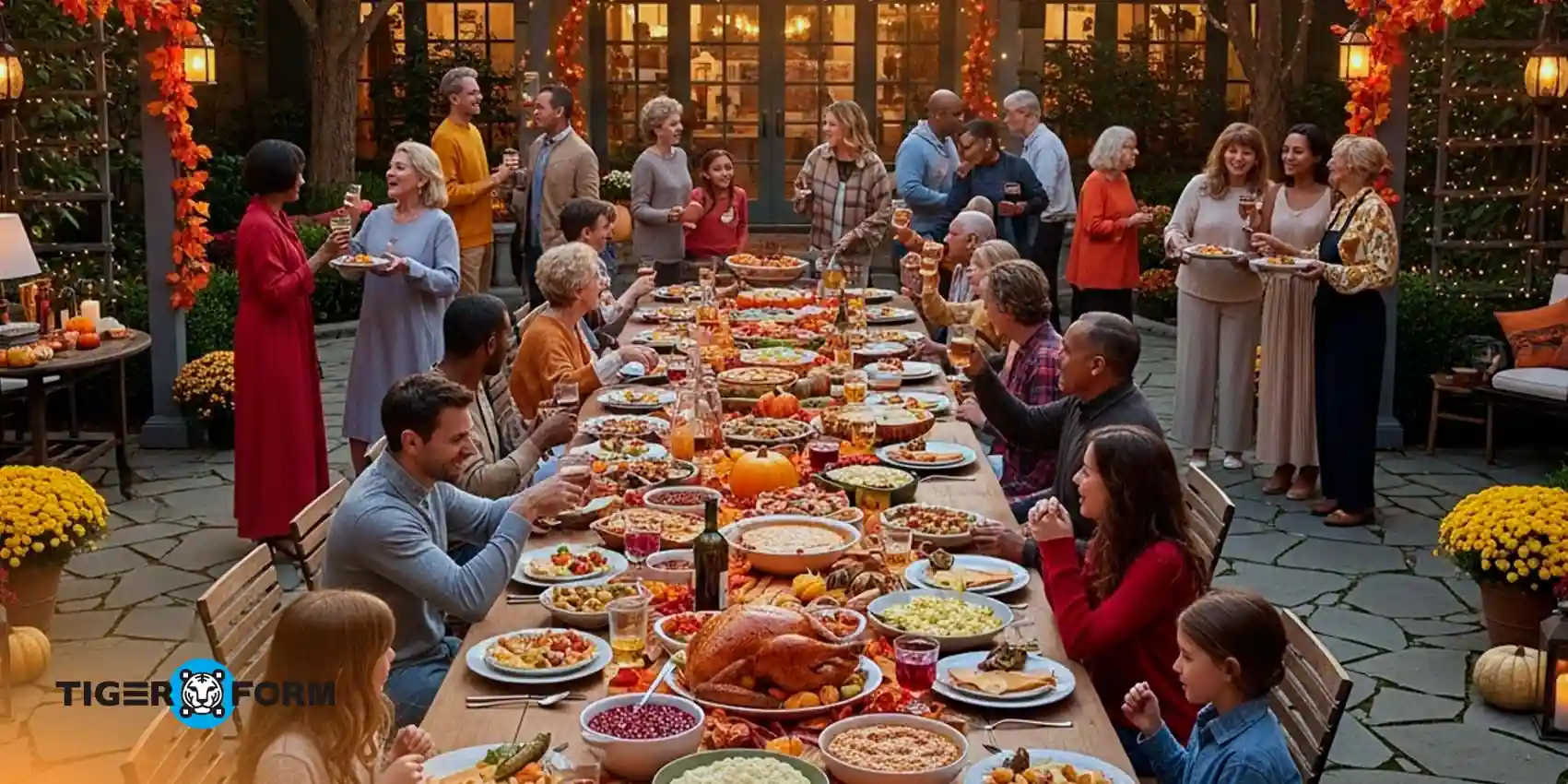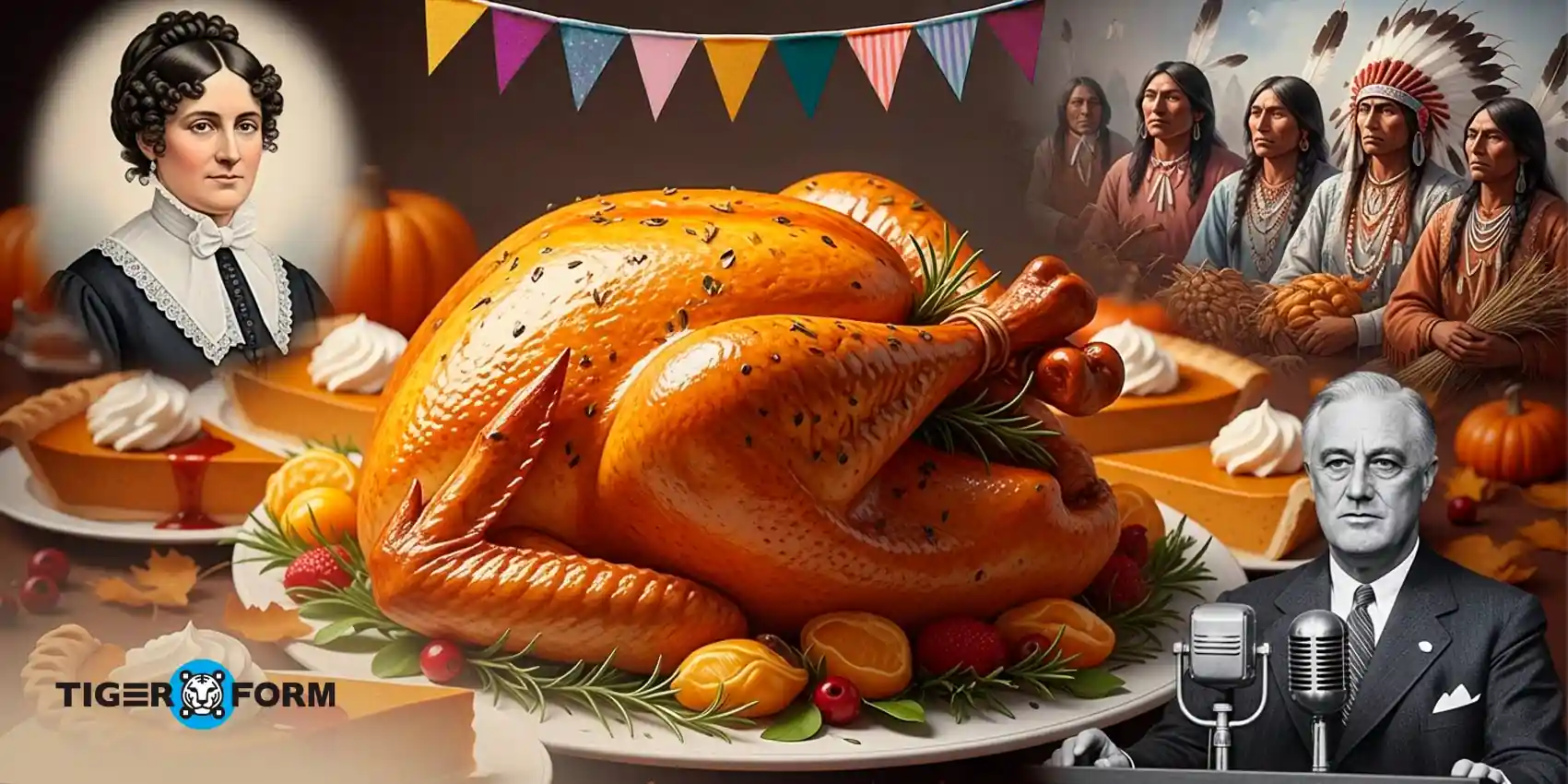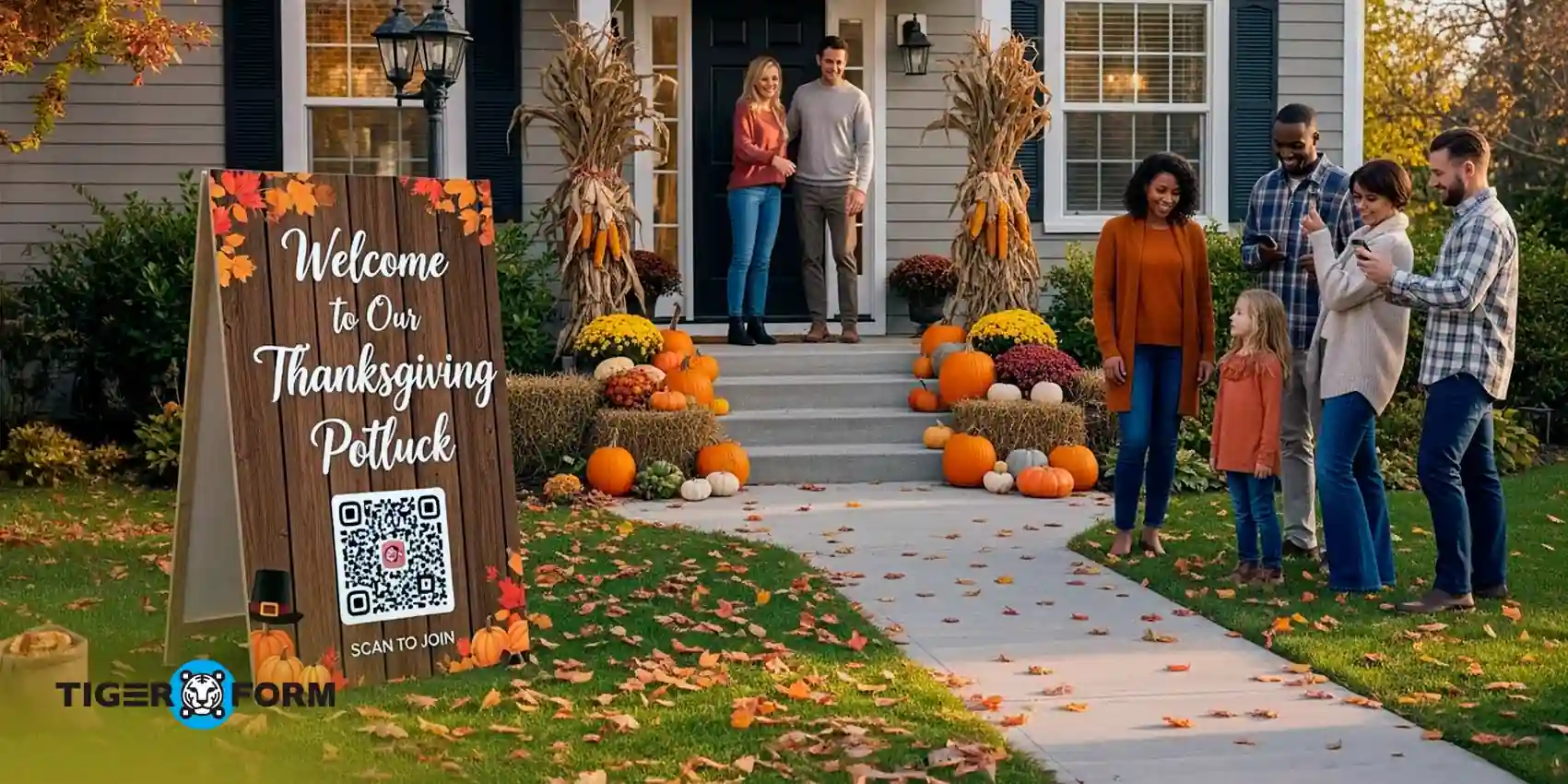
Thanksgiving Day is a national holiday in the United States, celebrated every fourth Thursday of November. It’s a time when people reconnect with their roots, spend quality time with family and friends to share a meal, and give thanks for life’s blessings.
The pinnacle of most celebrations is a large feast that typically includes turkey, stuffing, pies, and other traditional seasonal dishes. But beyond the grandiose celebrations, the day focuses on giving thanks for divine goodness shared throughout the year.
But have you ever wondered how this festive tradition began? If so, let’s look back at the history and surprising facts behind the Thanksgiving traditions. Later in this article, we will also discuss how QR form creators help you manage your guest list, potlucks, and more.
Brief history of Thanksgiving
1621 | The Plymouth harvest feast
The first Thanksgiving is traced to 1621 in Plymouth, Massachusetts. After a good harvest, the Pilgrims held a three-day feast. About 90 members of the Wampanoag tribe joined them, sharing food that included venison and fowl.
17th & 18th centuries | Colonial days of thanksgiving
In the New England colonies, “Days of Thanksgiving” were declared from time to time. These were primarily religious events, marked by prayer and fasting, to express gratitude for blessings such as rain or military victories. They were not yet yearly celebrations.
1789 | First national proclamation
President George Washington declared a national day of public thanksgiving and prayer. It was an important step, but it wasn’t yet a yearly or official holiday. Each state decided whether or not to observe it.
Mid-1800s | Sarah Josepha Hale’s campaign
Sarah Josepha Hale, the editor of a popular magazine and author of “Mary Had a Little Lamb,” spent almost forty years pushing for a national Thanksgiving holiday. She wrote letters and articles urging leaders to make it a unified celebration for the whole country.
1863 | Lincoln declares a national holiday
During the Civil War, President Abraham Lincoln made Thanksgiving a yearly national holiday on the last Thursday of November. He wanted the celebration to promote unity and gratitude across the nation.
1941 | Congress sets the permanent date
When President Franklin D. Roosevelt moved the date of Thanksgiving earlier during the Great Depression, it caused confusion and disagreement, earning the nickname “Franksgiving.” In 1941, Congress passed a law designating the official date as the fourth Thursday of November, which remains in effect today.
Traditions of American Thanksgiving

1. Roasting turkey
Turkey is the highlight at almost every American Thanksgiving table. It represents abundance and sharing because roasted turkeys are big enough to feed the whole family. For some, a celebration dinner without turkey feels incomplete.
Author Sarah Joseph Hale is credited with promoting the turkey as a staple of the Thanksgiving meal. In her 1827 novel “Northwood,” she described a Thanksgiving feast with roast turkey at the center, shaping how people saw the holiday meal.
2. Baking pumpkin pies
There is always room in our stomachs for desserts. And for Thanksgiving, pumpkin pie is the favorite; it represents the harvest season and the warmth of fall gatherings.
A fun fact, the first pilgrims couldn’t bake pies because they lacked ovens and ingredients, but they did have pumpkins, out of which they made stew and porridge. Later, when baking became possible, pumpkin pies became part of the tradition.
3. Making the most of leftovers
Turning leftovers into new dishes shows gratitude and practicality. It’s a way to extend the celebration beyond the days. With so much food cooked, families enjoy turkey sandwiches, soups, or hash in the days that follow. This habit has become a beloved post-Thanksgiving routine.
4. Family and gratitude
Thanksgiving is about more than food. It’s about family and being thankful for what we have. This tradition dates back to the first Thanksgiving, when gratitude was a matter of survival and blessings.
In 1863, Abraham Lincoln declared Thanksgiving a national holiday to remind Americans to stay united and thankful during the Civil War.
5. Watching Macy’s Thanksgiving Day parade
The Macy’s Parade marks the start of the holiday season. It features colorful floats, bands, and giant balloons that families watch together every year.
It began in 1924 as the “Macy’s Christmas Parade,” organized by store employees, many of whom were immigrants. A few years later, balloons replaced zoo animals and became the highlight of the event.
6. Watching the NFL (National Football League)
Football is another event on the Thanksgiving lineup. The tradition started in the late 1800s with college games, and the Detroit Lions made it part of the holiday in 1934.
The Dallas Cowboys joined the NFL in 1966, helping to create the doubleheader tradition. For many families, watching the games has become a bonding experience that makes Thanksgiving more memorable, much like how sports registration forms bring people together for local games and community events.
7. Joining Turkey Trot
Many people start Thanksgiving with a Turkey Trot, a short, fun run that promotes fitness before the feast. The first Turkey Trot took place in Buffalo, New York, in 1896. Today, these runs are held across the country, often to raise money for charities and food drives.
It’s one of the few Thanksgiving activities that brings cause with fitness. Participants often sign up through a volunteer registration form to help organize food drives or assist at the run itself—a genuine way to celebrate Thanksgiving through gratitude and togetherness.
8. Presidential turkey pardon
Each year, the president takes part in a lighthearted event called the turkey pardon. A turkey is “spared” from being eaten, adding humor to the holiday. Turkeys have been sent to the White House since the 1870s, but the official tradition of pardoning turkeys began with President George H. W. Bush in 1989.
9. Black Friday early-morning sales
Black Friday marks the start of the Christmas shopping rush. It’s known for big sales that follow right after Thanksgiving.
The term originated in Philadelphia in the 1950s, describing the congested traffic that filled the streets after the holiday. Retailers later gave it a positive spin, calling it the day their sales go “in the black,” meaning profit.
10 surprising facts about American Thanksgiving Day

1. The First Thanksgiving was not named “Thanksgiving.”
Today’s Thanksgiving was based on the 1621 harvest celebration of the Pilgrims and the Wampanoag tribe.
In earlier times, Thanksgiving was a “harvest celebration” held only after great blessings from God, such as a good harvest after a long drought or a victory in battle. Now, it has become a yearly tradition that brings families together to celebrate gratitude in a simple, memorable way.
2. It was a three-day event
The 1621 celebration lasted three days and was attended by about 50 colonists and 90 Wampanoag men. The three-day event included outdoor activities, hunting, and games. It was a feast of thanks for the successful crop that would sustain them through the winter.
But for pilgrims, the day was a religious observance, during which they prayed and fasted to give thanks for the harvest spiritually.
3. Turkey wasn’t the main course on the 1621
While it is likely that some wildfowl, such as ducks and geese, were present, historical accounts suggest that the Wampanoag contributed five deer (venison) as the primary meat offering. For Wampanoag people, deer were a high-status staple and readily available in their forests.
4. Thanksgiving was initially a day of fasting
Many early colonial days of “Thanksgiving” were set aside for fasting, religious reflection, and prayer to thank God for a special providence (like the end of a drought).
5. A magazine editor set the date of the contemporary celebration
The effort to make Thanksgiving a national holiday was led for 35 years by a woman named Sarah Josepha Hale, the editor of ‘Godey’s Lady’s Book’ and the author of the nursery rhyme “Mary Had a Little Lamb.”
She finally convinced President Lincoln to declare it a national holiday in 1863 during the Civil War.
6. Thomas Jefferson refused to recognize Thanksgiving
President Jefferson opposed national proclamations of Thanksgiving, believing that a government-declared day of prayer conflicted with the separation of church and state.
7. President Roosevelt tried to move the celebration date
In 1939, President Franklin D. Roosevelt changed the date to the second-to-last Thursday in November to extend the Christmas shopping season and boost the economy during the Great Depression.
This decision was so controversial that it split the nation with different celebration dates. The two years it lasted were called “Franksgiving.” In 1941, Congress officially set Thanksgiving on the fourth Thursday of November.
8. “Jingle Bells” was written for Thanksgiving
The popular Christmas carol was originally titled “One Horse Open Sleigh” and was written in 1857 to be performed as a Thanksgiving song.
9. Americans eat more pie than turkey on Thanksgiving
It is estimated that 50 million pumpkin pies are consumed on Thanksgiving Day, and some surveys indicate that more Americans rank desserts and side dishes as their favorite parts of the meal over the turkey.
10. For many Native Americans, it is a national day of mourning
Since 1970, many Native Americans, particularly in the Northeast, have observed a National Day of Mourning on the holiday to remember the loss of land, life, and culture that followed the arrival of European colonists.
How QR code forms help in managing Thanksgiving events

QR online form makers are digital tools that create forms accessible through QR codes. This QR-based way provides easy access to your sign-up forms or RSVPs with just a mobile device.
Below is a clearer picture of how these digital tools help you manage your Thanks Giving Day 2025 events:
1. Instant RSVP and headcount
Guests can scan the QR code on your invite to open the RSVP forms. This way, you create an easy access channel for your guests with just their phones or other devices. Their replies go straight into one file, giving you an up-to-date headcount without sifting through texts or emails.
2. Simplified potluck coordination
Aside from obtaining the basic contact information of your guests, you can also inquire about their food preferences or any additional details required for the event. Create a form with a list of dishes for guests to pick from. The submissions will inform you of what you need to cover and help you avoid serving repeat dishes.
3. Automatic dietary needs collection
RSVP forms can include questions about food allergies or dietary preferences, such as vegetarian, vegan, or gluten-free. This helps you plan a menu that’s safe and comfortable for all guests without having to ask each person individually.
4. Effortless logistics and setup planning
Your form can ask guests how many people are coming or if they need a high chair or special seating. Online forms give you the convenience of gathering the extra details early on and remind you that even small details of your Thanksgiving events also matter.
5. Centralized information hub
A QR code at the entrance or on a table can open a page with all the key details, including Wi-Fi password, meal schedule, map, or welcome note. With QR online forms, you keep guests informed without needing an in-person agent to ask them questions.
6. Fast, contactless check-in
Each guest can get a unique QR code “ticket” in their confirmation email. Scanning it upon arrival allows for fast, contactless entry, eliminating the need for a paper guest list.
7. Easy post-event photo sharing
After the party, send a thank-you note or message with a QR code that links to a shared photo album. Guests can easily upload their photos, creating a whole album of memories; another simple task made easy with a form builder.
Make Thanks Giving Day 2025 more organized with QR forms
Thanksgiving has always been about gratitude, family, and togetherness. But managing the event doesn’t have to come with stress.
By using QR form tools, you can simplify every process of your parties for Thanks Giving Day 2025, from RSVPs to post-event sharing, so you can go easy on event management and focus more on celebrating.
Bring the heart of Thanksgiving back to the table with smart tools that make planning easy and memorable. Try creating your own QR-powered forms today with TIGER FORM!
FAQs
What is the significance of the presidential turkey pardon?
The presidential turkey pardon represents the lighter, more humorous side of Thanksgiving, while reminding people of the importance of mercy and goodwill. The act also reflects the holiday’s spirit of giving thanks and showing kindness.
What can I include in my QR Thanksgiving event form?
A Thanksgiving event form helps you organize guests, food, and activities. You can include fields such as:
- Name and contact information
- RSVP or attendance confirmation
- Number of guests
- Dish contributions for potlucks
- Volunteer sign-up for setup or cleanup
- Preferred activities or games
- Post-event feedback section for future planning
Sources:
https://www.bostonglobe.com/metro/regionals/south/2011/11/17/thanksgiving-day-through-history/hKyQEzA7sz3DujIUj338bP/story.html
https://www.civilwarmed.org/event/facebook-live-thanksgiving/
https://cricketmedia.com/blog/reading/time-for-november-december-issues/
https://parenting.firstcry.com/articles/thanksgiving-history-traditions-and-interesting-facts-for-kids/?ref=interlink
https://doi.org/10.1016/j.trc.2017.02.021
https://www.lawyer-monthly.com/2024/11/the-story-behind-thanksgiving-dinner/
https://core.ac.uk/download/617861344.pdf
https://www.freetour.com/berat/savor-albanian-cuisine-cooking-class-with-mama-nina-berat-castle
https://tagvault.org/blog/facts-about-thanksgiving-interesting-fun/
https://www.flomarching.com/articles/11223156-want-your-band-to-march-in-the-macys-parade-or-rose-parade-heres-how
